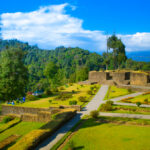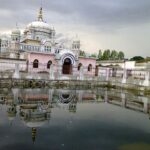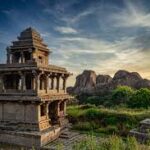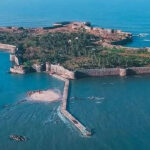Now Reading: Best Places Visiting in Aurangabad for History, Culture & Nature
-
01
Best Places Visiting in Aurangabad for History, Culture & Nature

Best Places Visiting in Aurangabad for History, Culture & Nature
1. amjhar sharif

Affection from Muslim believers makes Amjhar Sharif in the Aurangabad district of Bihar a significant religious destination. Every year numerous devotees visit the location to honor the Muslim saint Hazrat Saiyadana Mohammad Jilani Amjhari Quadri whose ancient mazaar (grave) resides there.
Best Time to Visit
Church visits at Amjhar Sharif are possible throughout the year yet the first week of June becomes the most visited period because of the Urs festivities.
Tips for Visitors
- You should wear modest clothing alongside respecting the cultural customs that exist at this site.
- A visit during the Urs festival will give you the chance to experience the place in its fullest spiritual atmosphere.
- Both respectfulness and quietness must be observed by visitors within the vicinity of the mazaar.
2. daud khan fort

Daudnagar Town stands alongside the eastern River Sone banks in Bihar as it guards the Daudnagar Fort. This fortress maintains its historic value by displaying Mughal architectural elements and strategic significance along with its Mughal-era history throughout its existence.
History
During the 17th century Daud Khan founded the fort as Bihar’s governor while answering to Mughal emperor Aurangzeb. Daud Khan used this area as his resting place after a triumphant return from conquest according to historical records. This strategic spot drew Daud Khan to found a town there which he christened Daudnagar using his own name.
During his time as Mughal emperor Aurangzeb awarded Daud Khan the authority to govern this territory because of his faithfulness. The town of Daudnagar prospered during the leadership of Daud Khan followed by his grandson Ahmed Khan when construction of both fortifications and mosques and ‘sarais’ (rest houses) took place for travelers.
Despite being lesser famous than bigger Mughal landmarks it maintains significant importance in Mughal historical and architectural history. Visitors can marvel at:
- The fortification style of Mughal architecture is visible through its gigantic stone walls. The walls endure despite their age since they retain their sense of majestic splendor.
- Intensely decorated gateways in the fort contain elaborate Mughal artistry that illustrates the architecture of that period.
- The Mughal influence on religious and cultural life of Daudnagar remains prominent through the surviving mosque that Daud Khan erected during his time.
- Daudnagar established ‘Sarais’ as establishments to accommodate traders together with travelers and soldiers moving through this territory. These reflect the importance of Daudnagar as a hub of activity during its heyday.
- The Town of Daudnagar
- The town of Daudnagar contains numerous sites that both students of historical heritage and visitors should experience due to their historic value.
- During Daud Khan’s rule the construction of the Daud Khan Mosque occurred and it remains notable for its Mughal architectural qualities through its simple design along with domes and arches.
- Ahmed Khan kept expanding Daudnagar after his grandfather through construction of additional rest houses and strengthening defensive fortifications across the town. Through his various additions Daud Khan created a vibrant marketplace which established Daudnagar as a busy cultural and trade hub throughout the Mughal period.
- Present-day Daudnagar remains alive through its vibrant markets that let visitors observe authentic local trades combined with traditional spices and food.
- Experience historical insights as well as tour the ancient mosque and gateways through an organized visit of the fort.
- Enjoy pleasant moments by walking along the River Sone as you appreciate the serene ambiance of the town.
- When visiting the town sample local Bihari cuisine by trying litti-chokha and sattu parathas alongside khaja which is a well-known sweet.
- Relax among local communities in surrounding villages where you can observe pottery trades combined with traditional fabric dyeing and natural farming activities dating back centuries.
Best Time to Visit
The most suitable period to explore Daudnagar stretches from October through March since these months provide comfortable weather conditions.
3. devkund sun temple
Devkund Sun Temple stands as a famed temple of Lord Surya (the Sun God) in the attractive Aurangabad district of Bihar. The sanctuary possesses extensive importance to Hindu faithful believers because it transforms into an active hub during the renowned Chhath Puja festival which draws multiple thousands of devotees who worship both sunset and sunrise.
Devkund Sun Temple serves both as a religious hub for devotion along with being a spot to encounter Bihar’s heritage while enjoying its peaceful wilderness.
Historical Significance of Devkund Sun Temple
The origins of Devkund Sun Temple date back to ancient times. In India the presence of Sun temples remains quite limited which makes Devkund Sun Temple even more important as a sacred place of worship. Sun worship belongs to central Hindu traditions because it symbolizes both powerful energy and life-giving force of God.
According to local tradition the temple gained its existence through a divine purpose to honor the Sun God so he would bestow upon his followers both physical well-being together with prosperity and spiritual wisdom. Ancient Hindu creators used intricate artistry to design the temple which contributes to its historical character.
Religious Importance
The spiritual value of Devkund Sun Temple remains deeply ingrained within its purpose. Lord Surya receives profound devotion at this temple which stands as one of the major sacred sites for his worship. Worshippers perform ‘Arghya’ which involves water rituals to the ascending and descending sun to achieve soul purification and divine blessings.
A massive number of devotees visit the temple between the four days of Chhath Puja to celebrate the worship rituals of Lord Surya alongside his two goddesses, Usha and Pratyusha. Devotees conduct religious rituals and maintain fasting while they carry out prayers to Lord Surya during sunrise and sunset near the temple pond.
Architectural Features
Devkund Sun Temple maintains a straightforward architectural layout which shows the traditional Hindu temple building practices from ancient times. Key features include:
Various stone-carved figurines depict divine beings along with heavenly entities.
The temple contains a holiest chamber known as the garbhagriha housing the main idol of Lord Surya.
The temple’s beauty increases through its substantial ritual pond (kund) that also functions as a religious bathing spot during festive occasions.
This sacred site maintains peace as well as spiritual energy to serve as a perfect location for spiritual contemplation and meditation.
Chhath Puja: A Grand Celebration
Devkund Sun Temple reveals its authentic beauty during Chhath Puja because this festival ranks as one of the major religious observances in Bihar. A considerable number of devotees visit the temple following Diwali to worship at the temple pond as part of their religious rituals.
The main attractions of Chhath Puja ceremonies at Devkund Sun Temple involve
The religious custom starts with a baptism followed by cooking and serving wholesome vegetarian food.
Kharna: Devotees symbolize the second day through fasting while making evening prayers.
Devotees perform evening prayers to the sunset on the occasion of Sandhya Arghya during the third day of the festival.
On the festival’s last morning people give their worship to the sunrise because it signals when fasting comes to an end.
The temple complex at Devkund Sun Temple becomes a breathtaking sight when devotees light it up with lamps during Chhath Puja to hear devotional songs.
Best Time to Visit
Visitors should plan to come to the temple during the Chhath Puja festivities because this period provides the best experience but the temple remains accessible throughout the entire year. People looking for tranquility can enjoy the peaceful weather conditions between October and March during the winter season.
Related articles : Top 4 Best Places Visiting in Dhemaji for Nature, Culture & Heritage
Stay Informed With the Latest & Most Important News
Previous Post
Next Post
-
 01Top 5 Best Places Visiting in Gyalshing – Monasteries, Lakes & Scenic Escapes
01Top 5 Best Places Visiting in Gyalshing – Monasteries, Lakes & Scenic Escapes -
 02Top 5 Best Places Visiting in Panna – Temples, Waterfalls & Wildlife Escapes
02Top 5 Best Places Visiting in Panna – Temples, Waterfalls & Wildlife Escapes -
 03Top 2 Best Places Visiting in Chitradurga for History, Nature & Adventure
03Top 2 Best Places Visiting in Chitradurga for History, Nature & Adventure -
 04Top 10 Best Places Visiting in Dakshina Kannad for Culture, Nature & Coastal Charm
04Top 10 Best Places Visiting in Dakshina Kannad for Culture, Nature & Coastal Charm -
 05Top 5 Best Places to Visit in Malerkotla – Malerkotla Fort, Sheesh Mahal & More
05Top 5 Best Places to Visit in Malerkotla – Malerkotla Fort, Sheesh Mahal & More -
 06Best Places Visiting in Shopian – Explore Top Attractions & Hidden Gems
06Best Places Visiting in Shopian – Explore Top Attractions & Hidden Gems -
 07Top 10 Best Places to Visit in Sindhudurg for Beaches, Forts & Nature
07Top 10 Best Places to Visit in Sindhudurg for Beaches, Forts & Nature














Pingback: Best Places to Visit in Banka – Explore Bihar's Hidden Gem